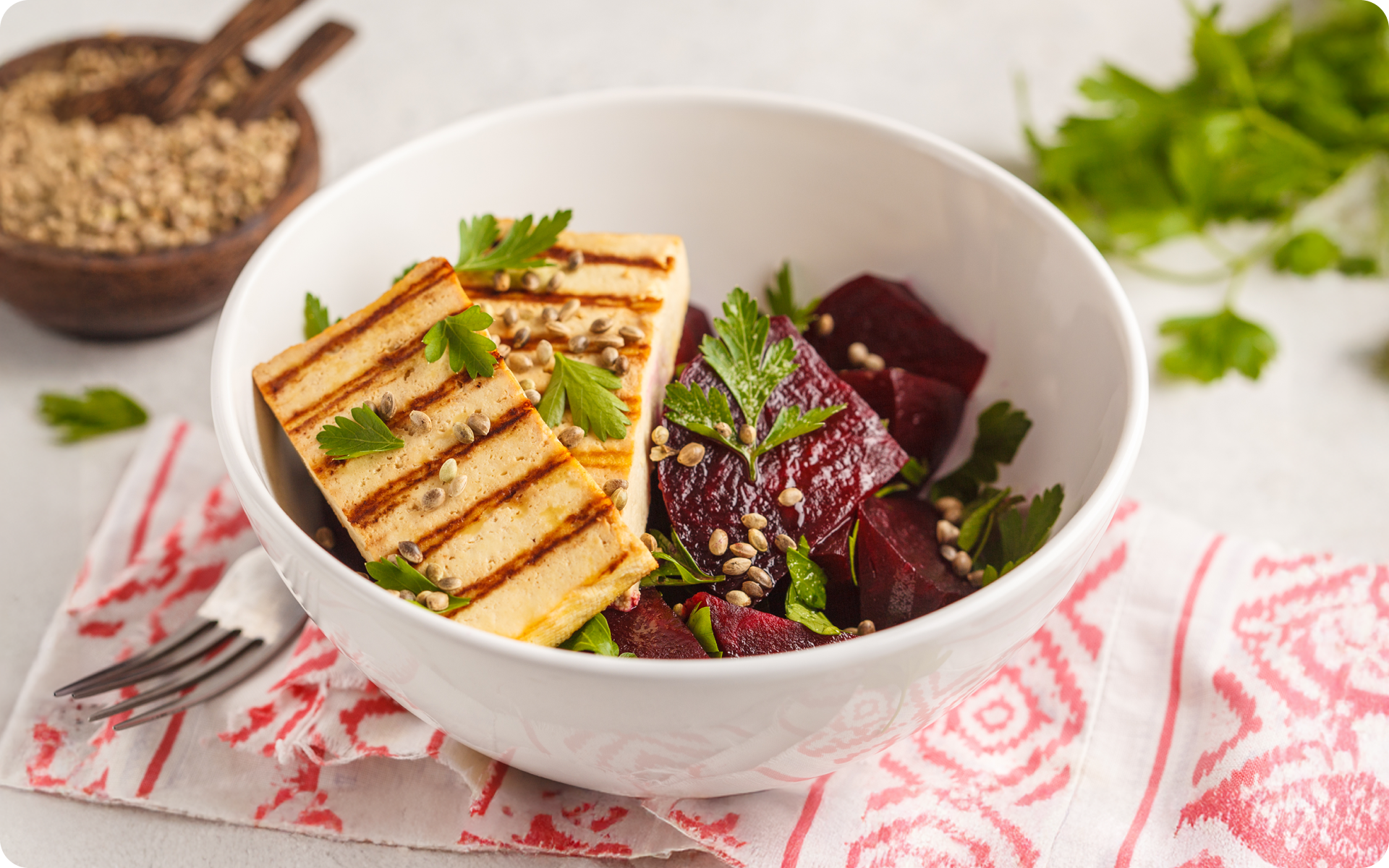Protein is an essential nutrient for anyone who is looking to improve their overall health and fitness, whether it’s building muscle or shedding unwanted weight. It plays a vital role in repairing and building tissues, producing enzymes and hormones, and maintaining healthy bones, skin, and blood (10). It’s no wonder people are searching for the optimal daily protein intake to maximize their health benefits.
However, the recommendations surrounding protein consumption are often inconsistent and contradictory, which leaves many individuals at a loss for how much they should be eating daily. In this article, we aim to provide a comprehensive, research-backed answer to the question, “Is consuming 100 grams of protein daily safe and sustainable?”
We’ll discuss the factors to consider when determining your ideal protein intake, the best sources of high-quality protein, and practical ways to incorporate them into your diet.
Is 100 Grams of Protein a Day Good for You?
Eating 100 grams of protein a day can be beneficial for some people, but you must consider various factors before you determine whether this intake is suitable for your specific needs. The recommended daily protein intake varies depending on age, gender, activity level, and individual goals.
The Institute of Medicine (IOM) suggests that the recommended daily allowance (RDA) for protein intake is 0.8 grams per kilogram of body weight for adults (7). This translates to approximately 56 grams for men and 46 grams for women per day.
However, these recommendations are based on sedentary individuals and may not account for those who engage in regular exercise or have specific fitness goals.
For individuals who are aiming to build muscle or lose weight, research suggests that consuming higher amounts of protein may be beneficial.
A common recommendation for athletes and those who engage in strength training is to consume 1.4-2.0 grams of protein per kilogram of body weight (12). In this case, eating 100 grams of protein a day could be appropriate for someone who weighs between 50 and 83 kilograms (110-183 pounds).
It should be noted that consuming 100 calories of protein isn’t the same as consuming 100 grams of actual protein.
Protein contains four calories per gram, so 100 grams of protein would provide 400 calories (3). This may be important for individuals who want to lose or gain weight. In terms of eating 100 grams of protein a day for weight loss, it’s important to pay attention to overall calorie intake.
There are special considerations to keep in mind when you’re aiming for a higher protein intake, such as ensuring you consume high-quality protein sources. It’s also important to maintain a balanced diet that incorporates adequate amounts of carbohydrates, fats, vitamins, and minerals together with your protein intake.
Which Food Has 100 Grams of Protein?
So what does 100 grams of protein look like? No single food item typically contains exactly 100 grams of protein. To consume 100 grams of protein in a day, you would need to combine various protein-rich foods in appropriate portions.
Here are some examples of high-protein foods and their protein content per serving, based on data from the United States Department of Agriculture (USDA):
- Chicken breast (cooked, skinless): A 100-gram serving contains approximately 32 grams of protein (5).
- Lean beef (90% lean, cooked): A 100-gram serving provides approximately 27 grams of protein (2).
- Salmon (cooked): A 100-gram serving contains approximately 25 grams of protein (8).
- Almonds: A 100-gram serving (about 23 almonds) offers approximately 21.4 grams of protein (15).
- Tofu (firm, raw): A 100-gram serving contains approximately 17.3 grams of protein (20).
- Greek yogurt (non-fat): A 100-gram serving offers approximately 10.3 grams of protein (24).
- Lentils (cooked): A 100-gram serving provides approximately 9 grams of protein (13).
- Quinoa (cooked): A 100-gram serving contains approximately 4.4 grams of protein (18).
To create a meal plan that includes 100 grams of protein, you can mix and match these sources throughout the day.
BetterMe app will provide you with a host of fat-frying fitness routines that’ll scare the extra pounds away and turn your body into a masterpiece! Get your life moving in the right direction with BetterMe!
For example, you could consider the following:
- Breakfast: A 200-gram serving of Greek yogurt (20 grams of protein) with a 30-gram serving of almonds (6 grams of protein).
- Lunch: A 100-gram serving of cooked chicken breast (31 grams of protein) with a side of vegetables.
- Dinner: A 100-gram serving of cooked salmon (25 grams of protein) with a 100-gram serving of cooked quinoa (4.4 grams of protein) and a side salad.
- Snack: A 100-gram serving of cooked lentils (9 grams of protein) in a salad or as part of a soup.
This meal plan provides a total of approximately 95.4 grams of protein, which is close to the target of 100 grams.
Remember that other foods you consume throughout the day, such as fruits, vegetables, and grains, will also contribute small amounts of protein, which will help you reach or exceed the 100-gram goal.
What Are Some High-Quality Protein Sources?
High-quality protein sources contain all the essential amino acids and are easily digestible by the body.
Here’s a list of high-quality protein sources:
Lean Meats
- Chicken breast: Low in fat, high in protein, and a good source of vitamins and minerals such as niacin, vitamin B6, and selenium.
- Turkey: Lean, high in protein, and rich in nutrients such as zinc, potassium, and vitamin B6.
- Lean beef: High in protein, iron, and vitamin B12, which is essential for energy production and brain function (21).
Seafood
- Salmon: Rich in omega-3 fatty acids, which support heart health, and contains vitamins D and B (16).
- Tuna: High in protein and packed with omega-3 fatty acids, potassium, and magnesium.
- Shrimp: Low-fat, high-protein source containing antioxidants such as selenium and astaxanthin.
Dairy Products
- Greek yogurt: High in protein, calcium, and probiotics that support gut health (23).
- Cottage cheese: Rich in protein, calcium, and phosphorus, and low in fat.
- Skim milk: Provides protein, calcium, and vitamin D while being lower in fat than whole milk.
Eggs
- Whole eggs: Contain high-quality protein, healthy fats, and essential nutrients such as choline, vitamin D, and selenium.
- Egg whites: A low-calorie, high-protein option for those who are aiming to reduce their fat intake.
Plant-based Protein Sources:
- Lentils: High in protein, fiber, iron, and folate, which makes them great for vegetarians and vegans.
- Chickpeas: Rich in protein, fiber, and essential nutrients such as manganese and folate.
- Black beans: Packed with protein, antioxidants, and fiber, which are beneficial for heart health (1) (6).
- Quinoa: A complete plant-based protein containing all the essential amino acids and rich in fiber, magnesium, and iron.
- Edamame: High in protein, fiber, and essential nutrients like vitamin K and folate.
Soy Products
- Tofu: A versatile plant-based protein source, rich in calcium and iron, which is suitable for vegans and vegetarians.
- Tempeh: Contains high-quality protein, prebiotics, and a wide array of vitamins and minerals, including calcium and iron.
- Seitan: Made from wheat protein, high in protein, but should be avoided by those with a gluten sensitivity (9).
Nuts and Seeds
- Almonds: High in protein, healthy fats, fiber, and vitamin E, which supports skin health (22).
- Pumpkin seeds: Rich in protein, magnesium, and zinc, and beneficial for health (14).
- Chia seeds: Contain protein, omega-3 fatty acids, and soluble fiber, which helps regulate blood sugar levels (4).
Our Low-Calorie, High-Protein Guide has a few more meal ideas you can try. 
How Do I Get 100 Grams of Protein a Day?
To ensure you consume 100 grams of protein a day, it’s important to have a well-thought-out plan and incorporate various strategies. Here are some basic and non-generic solutions that can help you meet your daily protein intake:
1. Create a 100-Grams-of-Protein Meal Plan
Design a meal plan that includes diverse protein sources and distributes them throughout the day. This will help you track your protein intake and make adjustments as necessary.
For example, start with a high-protein breakfast, include protein-rich snacks, and add protein to your lunch and dinner. Planning your meals will ensure that you eat 100 grams of protein a day consistently.
2. Combine Different Protein Sources
To avoid monotony and ensure you get all the essential amino acids, you should mix and match various high-quality protein sources such as lean meats, poultry, fish, dairy products, legumes, tofu, and plant-based options.
Combining different sources makes your meals more enjoyable and assists you in reaching 100 grams of protein without overloading on a single food type.
Read more: 7-Day Weight Loss Low-Carb Diet: Choose High-Protein, High-Fiber, or Ultra-Low-Carb
3. Optimize Protein Intake for Weight Loss or Muscle Building
If your goal is 100 grams of protein a day for weight loss, you should focus on lean protein sources and pair them with fiber-rich vegetables and whole grains to maintain satiety (19).
For those who are aiming for 100 grams of protein a day to build muscle, you could consider consuming a protein-rich snack or shake within 30-60 minutes after your workout to support muscle recovery and growth.
4. Use Protein Powders and Supplements
If you’re struggling to meet your protein needs through whole foods alone, consider adding protein powders or supplements to your diet. They can be easily incorporated into smoothies, oatmeal, or yogurt, and help you reach your 100 grams of protein a day target.
5. Implement Meatless Protein-Rich Meals
For those who are following a vegetarian or vegan diet, getting 100 grams of protein a day can be achieved by incorporating plant-based protein sources such as legumes, tofu, tempeh, seitan, and high-protein grains such as quinoa.
You can also include dairy products and eggs if you’re not strictly vegan.
6. Use Smart Cooking Techniques
Enhance the protein content of your meals by employing cooking techniques that preserve or increase protein levels. For example, using Greek yogurt as a substitute for sour cream, adding extra egg whites to your morning scramble, or mixing lentils with rice to achieve a more protein-rich dish.
7. Track Your Protein Intake
Use a food diary or tracking app to monitor your daily protein consumption. This will help you identify any gaps that exist in your diet and make any necessary adjustments to ensure you’re consistently eating 100 grams of protein a day.
BetterMe will keep you laser-focused on your weight loss journey! Nutrient-packed meal plans, fat-blasting workouts, galvanizing challenges and much more. Try using the app and see for yourself!
FAQs
What does 100 grams of protein look like?
To achieve a daily intake of 100 grams of protein, you can combine various foods throughout the day. Here are some food combinations that could help you reach this target:
- Breakfast
- 3 scrambled eggs (18g protein)
- 1 cup of Greek yogurt (10g protein)
- 2 slices of turkey bacon (6g protein)
- Lunch
- Grilled chicken breast (30g protein)
- Quinoa salad with chickpeas (15g protein)
- 1/4 cup of almonds (8g protein)
- Snack
- Protein shake with whey protein powder (20g protein)
- Dinner
- Salmon filet (25g protein)
- Lentil soup (18g protein)
- Side portion of broccoli (4g protein)
These combinations provide a total of approximately 100 grams of protein throughout the day. Remember to adjust portion sizes based on your dietary needs and consult a nutritionist for personalized recommendations.
Check out our High-Protein Breakfast Meal Prep post to get some inspiration for your next meals.
Is 100 grams of protein a day enough?
The ideal daily protein intake depends on factors such as age, gender, activity level, and individual goals. For sedentary individuals, the recommended daily allowance (RDA) is lower at 0.8 grams per kilogram of body weight (7).
However, for athletes and those who engage in strength training or who have specific fitness goals, consuming 100 grams of protein a day can be appropriate, depending on individual factors. Consult a healthcare professional or registered dietitian to determine your optimal protein intake.
How much protein is in 100 grams of chicken?
A 100-gram serving of cooked, skinless chicken breast contains approximately 31 grams of protein (5).
How can I eat 100 grams of protein a day as a vegetarian?
Vegetarians can consume 100 grams of protein a day by incorporating plant-based protein sources such as legumes, tofu, tempeh, seitan, and high-protein grains such as quinoa into their diets. Dairy products and eggs can also be included if you’re not strictly vegan. Design a meal plan that combines these sources throughout the day in order to reach your target protein intake.
The Bottom Line
Consuming 100 grams of protein a day can be beneficial for many individuals, particularly those who are physically active or who have specific fitness goals. It’s essential to create a meal plan that incorporates diverse high-quality protein sources and ensures a well-balanced diet with adequate carbohydrates, fats, vitamins, and minerals.
DISCLAIMER:
This article is intended for general informational purposes only and does not serve to address individual circumstances. It is not a substitute for professional advice or help and should not be relied on for making any kind of decision-making. Any action taken as a direct or indirect result of the information in this article is entirely at your own risk and is your sole responsibility.
BetterMe, its content staff, and its medical advisors accept no responsibility for inaccuracies, errors, misstatements, inconsistencies, or omissions and specifically disclaim any liability, loss or risk, personal, professional or otherwise, which may be incurred as a consequence, directly or indirectly, of the use and/or application of any content.
You should always seek the advice of your physician or other qualified health provider with any questions you may have regarding a medical condition or your specific situation. Never disregard professional medical advice or delay seeking it because of BetterMe content. If you suspect or think you may have a medical emergency, call your doctor.
SOURCES:
- Antioxidants, inflammation and cardiovascular disease (2014, ncbi.nlm.nih.gov)
- Beef, ground, 90% lean meat / 10% fat, loaf, cooked, baked (2019, fdc.nal.usd.gov)
- Biochemistry, Nutrients (2023, ncbi.nlm.nih.gov)
- Chia seeds (Salvia hispanica L.): A therapeutic weapon in metabolic disorders (2022, onlinelibrary.wiley.com)
- Chicken, broiler or fryers, breast, skinless, boneless, meat only, cooked, braised (2019, fdc.nal.usd.gov)
- Dietary Fiber Is Beneficial for the Prevention of Cardiovascular Disease: An Umbrella Review of Meta-analyses (2017, sciencedirect.com)
- Dietary protein intake and human health (2016, pubs.rsc.org)
- Fish, salmon, Atlantic, wild, cooked, dry heat (2019, fdc.nal.usd.gov)
- Gluten Sensitivity (2015, karger.com)
- Health Benefits of Dietary Protein throughout the Life Cycle (2020, intechopen.com)
- High-protein diet is bad for kidney health: unleashing the taboo (2019, academic.oup.com)
- International Society of Sports Nutrition Position Stand: protein and exercise (2017, ncbi.nlm.nih.gov)
- Lentils, mature seeds, cooked, boiled, with salt (2019, fdc.nal.usd.gov)
- Nutritional Value, Phytochemical Potential, and Therapeutic Benefits of Pumpkin (Cucurbita sp.) (2022, mdpi.com)
- Nuts, almonds, whole, raw (Foundation, 2346393) (2019, fdc.nal.usd.gov)
- Omega-3 Fatty Acids and Heart Health (2015, ahajournals.org)
- Protein Requirements and Recommendations for Older People: A Review (2015, mdpi.com)
- Quinoa, cooked (2019, fdc.nal.usd.gov)
- Satiation, satiety and their effects on eating behaviour (2009, onlinelibrary.wiley.com)
- Tofu, raw, firm, prepared with calcium sulfate (2019, fdc.nal.usd.gov)
- Vitamin B12 in Health and Disease (2010, mdpi.com)
- Vitamin E in dermatology (2016, ncbi.nlm.nih.gov)
- Yogurt and gut function (2004, academic.oup.com)
- Yogurt, Greek, plain, nonfat (2019, fdc.nal.usd.gov)









